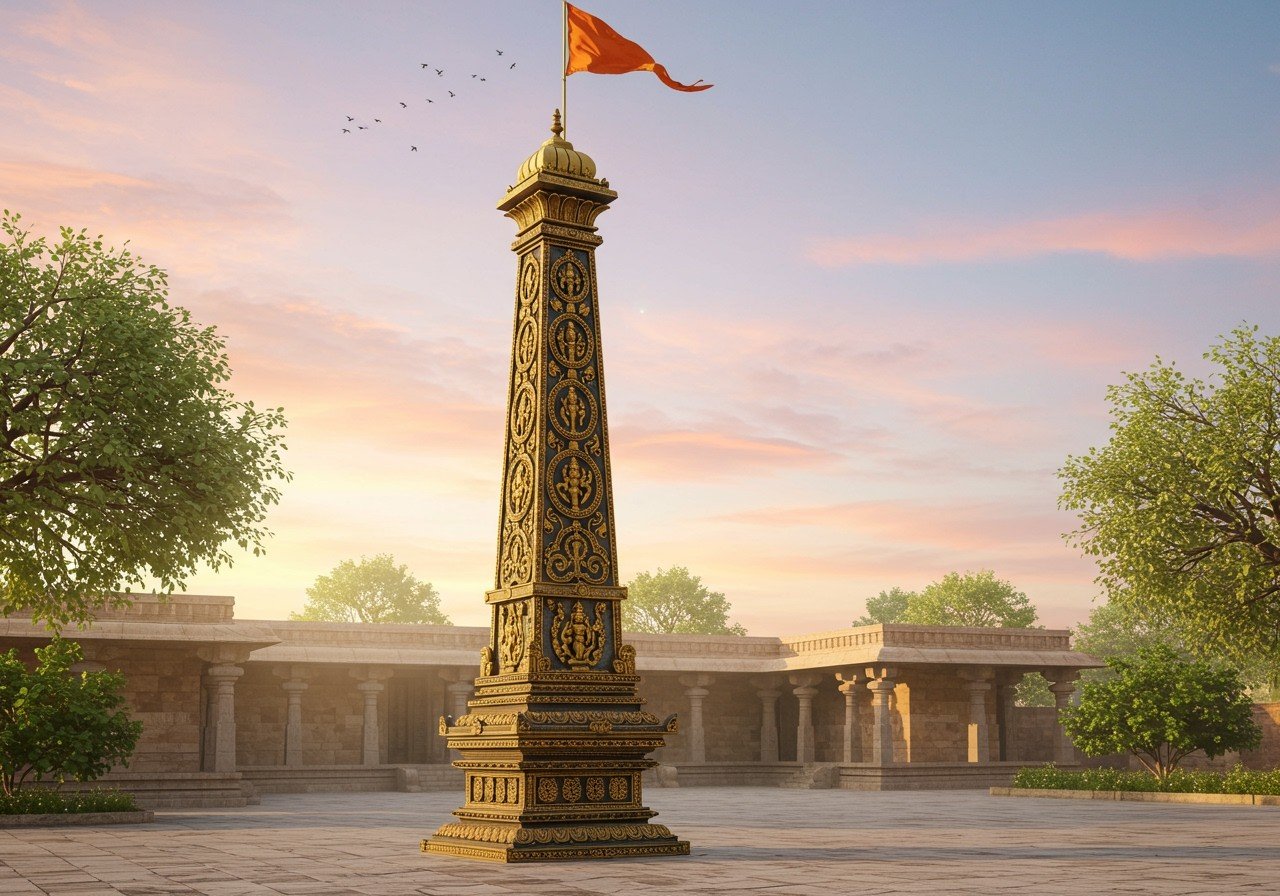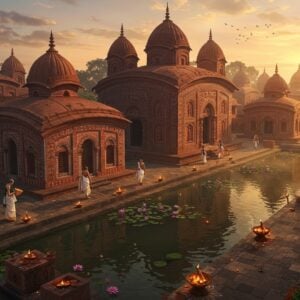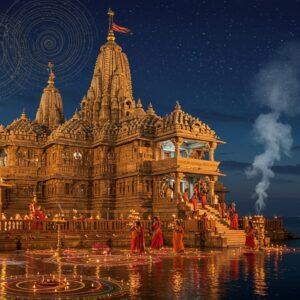Dwajasthambam: A Guide to Construction, Materials, and Costs (2025)

The Dwajasthambam, also known as Kodimaram, holds a vital place in Hindu temple architecture, symbolizing a link between the devotees and the divine. Positioned in front of the sanctum sanctorum, this sacred flagstaff is rich in symbolism and tradition. If you’re considering the construction and installation of a Dwajasthambam, understanding the materials, design principles, and costs involved is essential. This guide aims to offer insights into these aspects, especially for those who appreciate tradition and the convenience of online shopping for authentic ritual items.
Delving into Dwajasthambam Expenses
The cost of constructing a Dwajasthambam isn’t fixed; it depends on a confluence of factors. The choice of material plays a significant role. Opting for wood, like the sturdy teak favored for its longevity, or stone, like the resilient granite often seen in traditional temples, will influence the overall expenditure. Intricate carvings, demanding skilled craftsmanship, can elevate the cost. Regional variations in material availability and artisan expertise also contribute to price fluctuations. Sourcing materials in bulk or exploring online vendors like Poojn.in might offer some cost advantages. However, don’t forget to factor in transportation and installation, especially for larger, heavier Dwajasthambams. Bespoke designs, tailored to specific needs, can significantly impact the budget. When planning for a Dwajasthambam project in 2025, consider the effects of inflation and market trends for a clearer financial perspective.
Exploring Dwajasthambam Construction: A Step-by-Step Guide
The Dwajasthambam, a prominent feature of South Indian temples, is more than just a flagpole. It represents a connection between the earthly realm and the divine, symbolizing the temple’s identity and divine power. It is often accompanied by the Balipeetam (sacrificial altar) and the Vahana (the deity’s vehicle), further enriching its symbolic significance.
Materials and Design: Blending Tradition and Aesthetics
- Materials: Dwajasthambams are typically crafted from wood, stone, or metal.
- Wood: Strong, durable wood like teak is a popular choice, prized for its resilience and traditional appeal.
- Stone: Hard stones without cracks or veins, such as granite, are used, particularly in Telangana and Karnataka.
- Metal: Brass and copper are frequently used, sometimes adorned with copper, silver, or even gold plating.
- Shape and Structure: The Dwajasthambam’s form can be round, square, hexagonal, or octagonal.
- It stands as a pillar-like structure, often featuring three horizontal perches (Mekhala or Mekalai) at the top, pointing towards the Garbhagriha (sanctum sanctorum). These perches may have small bells attached, adding a melodious touch to the temple’s atmosphere.
- Some Dwajasthambams may have a single perch or a platform designed to hold an earthen lamp, symbolizing enlightenment and divine presence.
- Base: The base of the Dwajasthambam often rests on a large square structure, beautifully adorned with lotus petal arrangements.
- The lotus, a symbol of purity and divine creation, adds a layer of spiritual significance to the Dwajasthambam’s foundation.
- This base provides stability and anchors the structure, ensuring it stands tall and resilient against the elements.
Construction and Installation: Honoring Sacred Practices
- Guidance from Scriptures: The construction process follows the guidelines of Agamas, Vastu Shastra, and Shilpa Shastra, ensuring that the Dwajasthambam harmonizes with the temple’s overall design and spiritual purpose.
- These ancient texts offer detailed instructions on proportions, materials, and placement, preserving the sanctity and traditional significance of the Dwajasthambam.
- Adhering to these guidelines is considered essential for creating a Dwajasthambam that truly serves as a conduit between the earthly and the divine.
- Height and Visibility: The Dwajasthambam is built tall enough to be visible from afar, acting as a beacon of faith for the community.
- Some believe its height should ideally equal the height of the temple’s Sikara (tower above the sanctum), creating a harmonious balance within the temple complex.
- This visibility signifies the temple’s presence and invites devotees to participate in its sacred atmosphere.
- Safeguarding the Sanctum: A specific distance is maintained between the Dwajasthambam and the main deity to ensure that, in the unlikely event of it falling, it does not touch the Garbhagriha, preserving the sanctity of the inner sanctum.
- This precautionary measure underscores the reverence for the main deity and the importance of maintaining the purity of the Garbhagriha.
- It reflects a deep respect for the sacred space and a commitment to preserving its integrity.
Understanding Cost Factors: Planning Your Budget
The cost of a Dwajasthambam can vary significantly, influenced by factors like design complexity, materials used, size, labor involved, and the level of craftsmanship.
- Design Complexity: Simple designs may range from Rs. 20,000 to Rs. 40,000, while more intricate designs can exceed Rs. 5,00,000.
- The level of detail in the carvings, the incorporation of symbolic elements, and the overall artistry contribute to the design’s complexity and influence the final cost.
- Choosing a design that aligns with the temple’s aesthetics and budget is essential for a successful project.
- Materials: The choice of material significantly impacts the cost, with high-quality brass typically commanding a higher price.
- The cost of wood varies depending on the type and quality, with teak wood being a more expensive option due to its durability and resistance to termites.
- Stone Dwajasthambams can also vary in price based on the type of stone used and the complexity of the carvings.
- Size and Craftsmanship: Larger flagpoles require more material and craftsmanship, naturally increasing the overall cost.
- The height and diameter of the Dwajasthambam determine the amount of material needed, impacting the cost of raw materials and labor.
- The skill and experience of the artisans involved also play a crucial role in determining the final cost, as intricate carvings and detailed work demand a higher level of expertise.
Cost Examples: A Range of Possibilities
To give you a better understanding of the potential costs involved, here are some examples:
- A basic temple Dwajasthambam may start from Rs. 4,000.
- This entry-level price point provides a starting point for those seeking a simple yet dignified Dwajasthambam.
- It is important to note that this price may not include installation or additional features.
- Brass Temple Dwajasthambams can cost around ₹ 2,800 per kg.
- The weight of the brass used directly affects the cost, so larger and more elaborate designs will naturally be more expensive.
- Brass is a popular choice due to its durability, aesthetic appeal, and auspicious significance in Hindu tradition.
- A 32-foot Kodimaram (Dwajasthambam) Kavacham can cost up to ₹ 9,50,000.
- This example illustrates the potential cost of larger, more elaborate Dwajasthambams, especially those requiring specialized protective coverings (Kavacham).
- The Kavacham adds a layer of protection against the elements and enhances the Dwajasthambam’s longevity.
These are just examples, and the actual costs might differ based on customization and specific design choices. For high-quality, traditional puja items that can complement your Dwajasthambam, explore the collection at Poojn.in. Our range includes items like Alta and Dasha Mrittika, adding authenticity to your temple rituals.
Key Features to Consider: Ensuring Longevity and Significance
When planning the construction of a Dwajasthambam, consider these key features:
- Material: Durability and appearance are paramount. Choose a material that can withstand the elements and maintain its beauty over time.
- Teak wood is known for its natural resistance to decay and insects, while granite offers exceptional strength and longevity.
- Metal options like brass and copper can be aesthetically pleasing and symbolize prosperity and divinity.
- Height: Ensure sufficient height for visibility from a distance, making it a prominent landmark of faith.
- The height should be proportionate to the temple’s size and surrounding landscape.
- A tall Dwajasthambam enhances the temple’s grandeur and serves as a visual reminder of the divine presence.
- Design: Select a design that resonates with the temple’s cultural and architectural context.
- Traditional designs often incorporate intricate carvings and symbolic elements that enhance the Dwajasthambam’s spiritual significance.
- Consider consulting with skilled artisans and religious experts to create a design that honors tradition and reflects the temple’s unique identity.
- Base Stability: A stable base is crucial to prevent tilting and ensure the Dwajasthambam’s longevity.
- The foundation should be carefully designed and constructed to provide a solid base that can withstand the weight of the structure and potential environmental factors like wind and earthquakes.
- Proper drainage around the base is also important to prevent waterlogging and erosion, which can compromise the stability of the Dwajasthambam over time. Consulting with geotechnical and structural engineers helps to ensure that the foundation meets required standards.
- Symbolic Elements: Incorporate meaningful symbols and motifs that enhance the Dwajasthambam’s spiritual significance.
- Religious symbols like the lotus, the trident, and various deities can be incorporated into the design, enhancing the Dwajasthambam’s sacred meaning and connecting it to deeper spiritual concepts.
- Consider the placement of these symbols with respect to both aesthetics and religious customs; local artisans or religious leaders might offer guidance on this aspect.
- Low Maintenance: Choose materials and designs that require minimal upkeep, reducing long-term costs and effort.
- Materials like granite and metal are relatively low maintenance compared to wood, which requires regular treatments to prevent decay and insect infestation.
- Simpler designs with fewer intricate carvings are generally easier to clean and maintain than highly ornate designs.
Additional Factors: Location and Customization
- Customization: Explore customization options to personalize the Dwajasthambam and align it with the temple’s specific needs and aesthetics.
- Custom designs allow for the incorporation of unique features, such as specific deities, inscriptions, or symbolic elements that hold special meaning for the temple community.
- Customization may increase the overall cost but offers the opportunity to create a truly unique and meaningful Dwajasthambam that reflects the temple’s individual identity.
- Geographic Location: Consider the geographic location and availability of materials and craftsmen when planning your project.
- Local artisans may have expertise in working with specific materials or traditional designs, ensuring authenticity and cultural relevance.
- Transportation costs for materials can vary depending on the distance from the source, impacting the overall budget. Sourcing materials locally can sometimes reduce transportation costs and support the local economy.
While these estimations provide a helpful framework, remember that the actual cost can vary significantly. It depends on your specific requirements, chosen materials, and the artisans’ expertise. Poojn.in is here to assist you with authentic puja items and other needs. Contact us at 03369029784 for assistance. For quick questions, you can reach us on WhatsApp at 9476142738. Our Holy Idols collection might also be of interest as you plan your temple enhancements.
Embracing Tradition, Embracing Convenience
Constructing and installing a Dwajasthambam is a sacred undertaking, a blend of tradition, artistry, and devotion. It reflects the essence of the temple and the community’s spiritual aspirations. Understanding the materials, design nuances, and cost considerations allows for thoughtful planning and respectful execution of this sacred task. By appreciating the various options and considerations, we ensure that the Dwajasthambam fulfills its purpose for generations to come. Whether you choose the enduring strength of wood, the timeless appeal of stone, or the radiant beauty of metal, each material carries its unique charm and symbolic significance. While costs may vary, the spiritual value of a well-crafted Dwajasthambam is immeasurable. It stands tall as a testament to faith and dedication, firmly rooted in tradition and elevated by the skilled hands of artisans. Online platforms like Poojn.in provide access to authentic materials and guidance, seamlessly blending traditional practices with the convenience of modern technology. Traditional hand pankha & decorative items to decorate your home. As you embark on this journey of constructing a Dwajasthambam, may it be filled with reverence and fulfillment, bridging the earthly and the divine with grace and devotion. You can also look into brass murtis and Laxmi-Ganesha idols to enhance the spiritual atmosphere. For decorating your home, explore our Decoratives section. If you’re looking for specific brands, our Falcon collection offers a wide selection. And for all your puja needs, browse our range of Flammables, Holy Food, and Gems and Stones.


